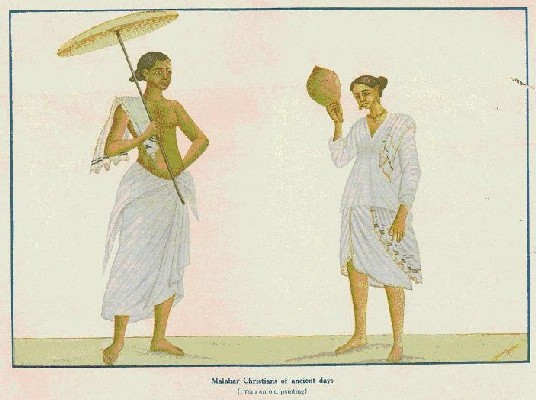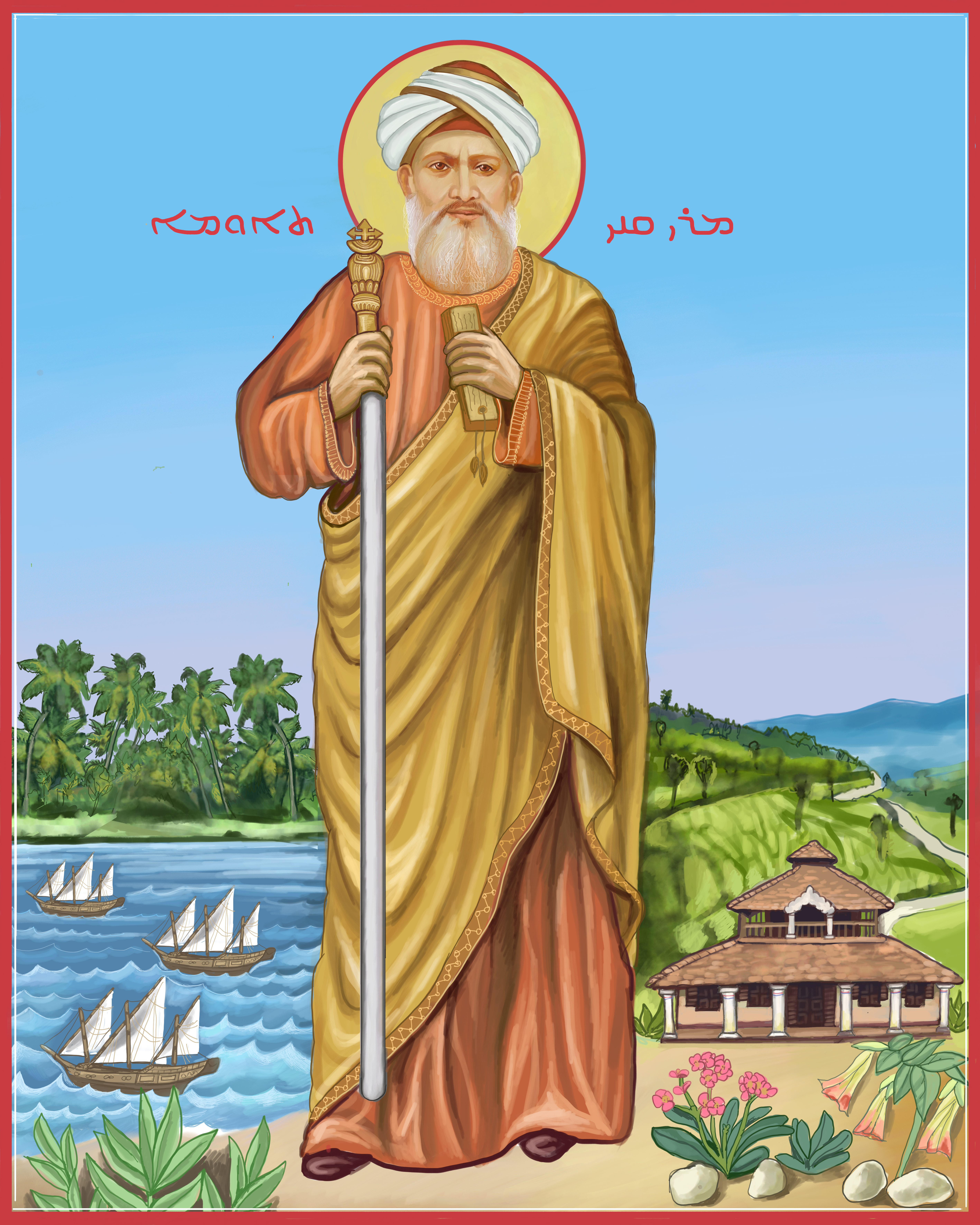|
Chattayum Mundum
''Chattayum Mundum'' is a traditional attire used by the Syrian Christian women of Kerala. It is a seamless white garment, consisting of a white blouse covering the whole upper part of the body (''"Chatta"'') and a long white garment called ''"Mundu"'' which is wrapped around the waist which reaches to the ankles. The "''Chatta''" is of Jewish origin and the "''Mundu''" is of South Indian origin. The ''Mundu'' used is 9.5 yards long. The ''"Chatta"'' or the Blouse would either be full sleeve which covers the whole arm or would be near to the elbow. A fan like appendage is also made in the backside by pleating the garment. A creamish white cloth with a golden border known as the ''"Kavani"'' or ''"Neriyathu"'' is worn over the left shoulder and tucked into the ''Mundu'' when the women are outside the house. Traditionally in the church the women cover themselves with another white cloth with a golden border ''"Kasavu"'' which is worn over the head covering the head and the shoulders ... [...More Info...] [...Related Items...] OR: [Wikipedia] [Google] [Baidu] |
Saint Thomas Christians
The Saint Thomas Christians, also called Syrian Christians of India, ''Marthoma Suriyani Nasrani'', ''Malankara Nasrani'', or ''Nasrani Mappila'', are an ethno-religious An ethnoreligious group (or an ethno-religious group) is a grouping of people who are unified by a common religious and ethnic background. Furthermore, the term ethno-religious group, along with ethno-regional and ethno-linguistic groups, is a s ... community of Indian Christians in the state of Kerala (Malabar region), who, for the most part, employ the East Syriac Rite, Eastern and West Syriac Rite, Western liturgical rites of Syriac Christianity. They trace their origins to the evangelistic activity of Thomas the Apostle in the 1st century. The Saint Thomas Christians had been historically a part of the hierarchy of the Church of the East but are now divided into several different Eastern Catholic Church, Eastern Catholic, Oriental Orthodoxy, Oriental Orthodox, Protestantism, Protestant, and independent ... [...More Info...] [...Related Items...] OR: [Wikipedia] [Google] [Baidu] |
Mundu
The mundu (Malayalam: ; ) is a garment worn around the waist in the Indian states of Kerala, Tamil Nadu, the Lakshadweep archipelago, and the Indian Ocean island nation of Maldives. It is closely related to sarongs like dhotis and lungis. It is normally woven in cotton and coloured white or cream. The colour is dependent on whether the cotton is bleached or unbleached. A is made using handlooms. When unbleached, the mundu is called . In modern times, two types of mundu are prevalent—the single and the double. A single mundu is wrapped only once around the waist, while the double one is folded in half before wearing. A mundu is usually starched before use. Men A mundu usually has a line of comparatively thicker cloth woven into it near the border called the ''kara''. The ''kara'' can be coloured and comes in various sizes. There is also double coloured and ornamental ''kara'' (a strip of colour at the end of the mundu). For more ceremonial occasions (like weddings), a mun ... [...More Info...] [...Related Items...] OR: [Wikipedia] [Google] [Baidu] |
Jews
Jews ( he, יְהוּדִים, , ) or Jewish people are an ethnoreligious group and nation originating from the Israelites Israelite origins and kingdom: "The first act in the long drama of Jewish history is the age of the Israelites""The people of the Kingdom of Israel and the ethnic and religious group known as the Jewish people that descended from them have been subjected to a number of forced migrations in their history" and Hebrews of historical History of ancient Israel and Judah, Israel and Judah. Jewish ethnicity, nationhood, and religion are strongly interrelated, "Historically, the religious and ethnic dimensions of Jewish identity have been closely interwoven. In fact, so closely bound are they, that the traditional Jewish lexicon hardly distinguishes between the two concepts. Jewish religious practice, by definition, was observed exclusively by the Jewish people, and notions of Jewish peoplehood, nation, and community were suffused with faith in the Jewish God, ... [...More Info...] [...Related Items...] OR: [Wikipedia] [Google] [Baidu] |
South India
South India, also known as Dakshina Bharata or Peninsular India, consists of the peninsular southern part of India. It encompasses the Indian states of Andhra Pradesh, Karnataka, Kerala, Tamil Nadu, and Telangana, as well as the union territories of Lakshadweep and Puducherry, comprising 19.31% of India's area () and 20% of India's population. Covering the southern part of the peninsular Deccan Plateau, South India is bounded by the Bay of Bengal in the east, the Arabian Sea in the west and the Indian Ocean in the south. The geography of the region is diverse with two mountain ranges – the Western and Eastern Ghats – bordering the plateau heartland. The Godavari, Krishna, Kaveri, Tungabhadra, Periyar, Bharathappuzha, Pamba, Thamirabarani, Palar, and Vaigai rivers are important perennial rivers. The majority of the people in South India speak at least one of the four major Dravidian languages: Tamil, Telugu, Malayalam and Kannada (all 4 of which are among the 6 Classic ... [...More Info...] [...Related Items...] OR: [Wikipedia] [Google] [Baidu] |
Kasavu
Kasavu is a technique used in handlooms of Kerala, with very fine threads of gold or silver used in weave to make border lines and designs on silk and cotton fabrics. This technique later spread to most of India and the Kasav technique was developed for many other fabrics across India. White or off-white cotton cloth with Kasav borders that originated in the South Indian state of Kerala is now famous as Kerala saree is believed to be first form of use of Kasav technique. Origins The original ''kasavu'' was made by hand using fine golden or silver threads to make border lines or designs on cotton or silk fabrics. It is believed to date back to the Buddhist era and continues to be worn by Malayalis, the residents of Kerala. It is worn by both women and men, especially during festivals, dances, and special occasions such as weddings and ''piranna naal'' (birthdays according to the local calendar.) During the ''Vishu'' festival, it is customary to place a brand new ''kasavu'' cloth n ... [...More Info...] [...Related Items...] OR: [Wikipedia] [Google] [Baidu] |
Margamkali
Margamkali (Malayalam:മാർഗ്ഗംകളി ) is an ancient Indian round dance of the St. Thomas Christians community- based in Kerala state, mainly practiced by the endogamous sub-sect known as the Knanaya or Southist Christians. The dance retells the life and missionary work of Thomas the Apostle, based on the 3rd-century apocryphal Acts of Thomas. History There are several opinions on the potential origin of Margamkali. They are: # It is traced back to Jewish wedding songs and dance from the diaspora.Neumann K (1998) "Mond, Gott Siva und heiliger Thomas: Die religiöse Gemeinschaft der Knanaya in Kerala" Universität Marburg p 150 Scholars have found common origin among Malabar Jewish dance and songs and the dance form of Margamkali.Vellian, J (1990) 'Crown, veil, cross : marriage rites' in Syrian churches series, vol 15 p 30 In addition, scholars like P.M. Jussay and Dr Shalva Weil have found many similarities in the customs and rituals of Knanaya Christians and ... [...More Info...] [...Related Items...] OR: [Wikipedia] [Google] [Baidu] |
Malabar Christians Of 19th Century
Malabar may refer to the following: People * Malabars, people originating from the Malabar region of India * Malbars or Malabars, people of Tamil origin in Réunion Places * Malabar Coast, or Malabar, a region of the southwestern shoreline of India ** Dutch Malabar (1661–1795) ** Malabar District (1792–1957) ** Malabar rainforests, ecoregions * Malabar, Indonesia ** Malabar Radio Station * Mount Malabar, a volcano in Indonesia * Malabar, Florida, United States * Malabar Island, part of the Aldabra Atoll, Seychelles * Malabar Settlement, Trinidad and Tobago * 754 Malabar, a minor planet * Malabar, New South Wales, Australia **Malabar Headland Transportation and military * Malabar Express, a train service in India * Malabar (train), a train service in Indonesia * List of ships named ''Malabar'' * , the name of several ships and a shore establishment of the Royal Navy * , the name of a number of steamships * , a US Navy World War II stores ship * Malabar (naval exercise), ... [...More Info...] [...Related Items...] OR: [Wikipedia] [Google] [Baidu] |
Syrian Christian Women In Kerala (1912)
Syrians ( ar, سُورِيُّون, ''Sūriyyīn'') are an Eastern Mediterranean ethnic group indigenous to the Levant. They share common Levantine Semitic roots. The cultural and linguistic heritage of the Syrian people is a blend of both indigenous elements and the foreign cultures that have come to inhabit the region of Syria over the course of thousands of years. The mother tongue of most Syrians is Levantine Arabic, which came to replace the former mother tongue, Aramaic, following the Muslim conquest of the Levant in the 7th century. The conquest led to the establishment of the Caliphate under successive Arab dynasties, who, during the period of the later Abbasid Caliphate, promoted the use of the Arabic language. A minority of Syrians have retained Aramaic which is still spoken in its Eastern and Western dialects. In 2018, the Syrian Arab Republic had an estimated population of 19.5 million, which includes, aside from the aforementioned majority, ethnic minorities such as ... [...More Info...] [...Related Items...] OR: [Wikipedia] [Google] [Baidu] |
Knanaya Margam Kali
The Knānāya, (from Syriac: ''Knā'nāya'' (Canaanite)) also known as the Southists or Tekkumbhagar, are an endogamous ethnic group found among the Saint Thomas Christian community of Kerala, India. They are differentiated from another part of the community, known in this context as the Northists (''Vaddakkumbhagar''). There are about 300,000 Knanaya in India and elsewhere. The origins of the Knanaya community is traced back to the arrival of the Syriac merchant Thomas of Cana (Knāi Thoma) who led a migration of Syriac Christians ( Jewish-Christians) from the Mesopotamian province of Sassanian Persia to India in the fourth or eighth century. The communities arrival was recorded on the Thomas of Cana copper plates which were extant in Kerala until the 17th century. The ethnic division between the Knanaya and other St. Thomas Christians was observed during the Portuguese colonization of India in the 16th century and was noted throughout the European colonial era. Today, the majo ... [...More Info...] [...Related Items...] OR: [Wikipedia] [Google] [Baidu] |
Dresses
A dress (also known as a frock or a gown) is a garment traditionally worn by women or girls consisting of a skirt with an attached bodice (or a matching bodice giving the effect of a one-piece garment). It consists of a top piece that covers the torso and hangs down over the legs. A dress can be any one-piece garment containing a skirt of any length, and can be formal or casual. A dress can have sleeves, straps, or be held up with elastic around the chest, leaving the shoulders bare. Dresses also vary in color. The hemlines of dresses vary depending on modesty, weather, fashion or the personal taste of the wearer. Overview Dresses are outer garments made up of a bodice and a skirt and can be made in one or more pieces. Dresses are generally suitable for both formal wear and casual wear in the West for women and girls. Historically, dresses could also include other items of clothing such as corsets, kirtles, partlets, petticoats, smocks, and stomachers. History 11t ... [...More Info...] [...Related Items...] OR: [Wikipedia] [Google] [Baidu] |




